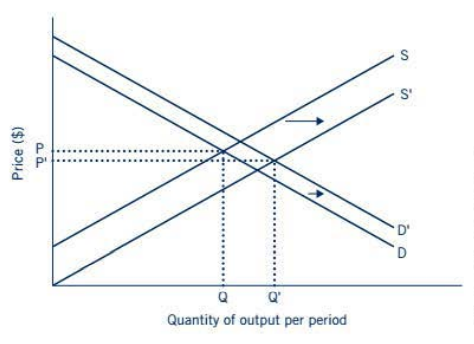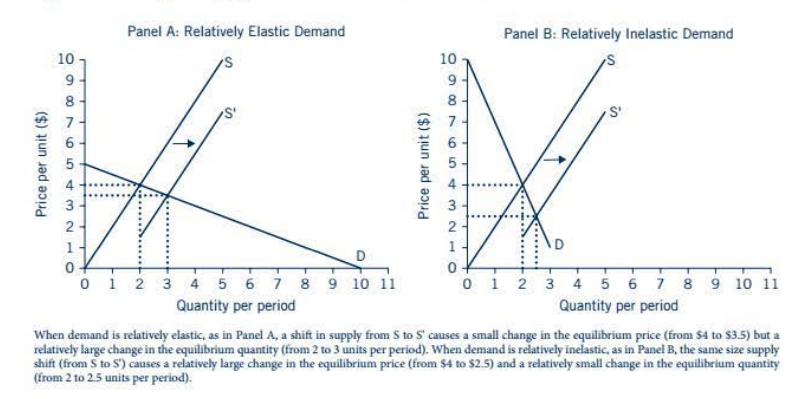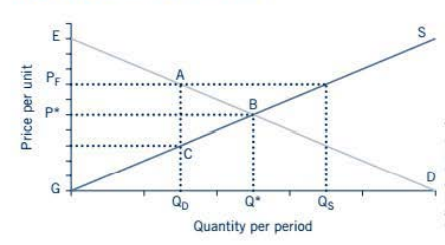
Chapter 14: Farm Policy
Two characteristics have contributed to government's long-standing involvement in agricultural markets. The first is the long-term decline in agricultural employment; the second is the inelastic nature of the demand for agricultural products.
Accompanying the decline in employment in agriculture is a change in the concentration of agricultural production away from small family farms and toward larger-scale commercial producers.
The decline in the number of farms has been coupled with increased specialization in agricultural production.
American farms do not tend to grow a wide variety of crops or livestock. Instead, each farm specializes in the production of a small number of relatively specific commodities.
Agriculture has moved from an industry of primarily rural family farms to an increasingly specialized business with a high degree of technological sophistication and high levels of productivity.
Due to the better technology, a lot of work that was previously done by labour is now done with machines to increase the output. Due to this, there has been an increase in unemployment and decline in the agricultural areas.
On the one hand, the increase in demand would cause higher prices and output of agricultural goods. At the same time, however, the increase in supply would lead to increased output but decreases in agricultural prices. Although both shifts generate increases in output, the demand and supply model cannot give us a clear prediction about the prices of agricultural output without more information.

The graph above illustrates the combined demand and supply shifts.
The increase in supply is illustrated by the shift from S to S'.
By itself, this shift in supply would generate increased output and decreased prices for agricultural goods.
The demand shift, illustrated by the move from D to D', causes an increase in agricultural output and prices.
The demand and supply shifts together cause agricultural output to increase from Q to Q'. The shifts have opposite effects on equilibrium prices.
The fact that we have seen a decrease in the inflation-adjusted prices of agricultural goods and services over time implies that the supply shift must have more than offset the demand shift, as shown by the reduction in price from P to P'.
If the demand shift is larger than the supply shift, prices will rise. Alternatively, if the supply shift is larger, prices will fall.
The demand curves for products with inelastic demand tend to be steep relative to the demand curves for goods with more elastic demand. The inelastic demand for agricultural products implies that changes in supply in agricultural markets do not cause large changes in equilibrium quantity but do cause large fluctuations in price.
The changes in supply when demand is Elastic and Inelastic is given below:

Because agriculture is also subject to relatively large changes in supply across time due to bumper crops, drought, disease, and other factors, the prices of agricultural goods tend to be more volatile than prices in other industries.
A subsidy is a program of financial or other assistance given to a business or industrial sector.
A price support is a policy aimed at preventing the price of a given good of service from falling below a target level.
A price floor is minimum amount that can be legally charged for a good or service.
The graph below illustrates the impact of a price floor in an agricultural market.

Suppose that the equilibrium price of the good is p* and the equilibrium quantity of the good traded per period is Q* .
Suppose also that a price floor is established at price P(f).
At P(f), the quantity demanded is Q(D) , the quantity supplied is Q(S), and there is a market surplus of O(S) - Q(D) of the good per period.
If the market were allowed to adjust to the surplus created at price P(f) the surplus would be eliminated as suppliers reduce the quantity of the good they supply and the price falls to p*.
In the case of a price floor, however, the price is prevented from falling below P* so the surplus will not eliminated by the market.
Consumers will purchase Q(D) of the good, but the rest of the good produced will remain as surplus.
Supply restrictions raise the prices of agricultural goods by reducing their supply.
Given the relatively inelastic demand faced in the agriculture sector, supply restriction programs cause higher equilibrium prices but have only small impacts on equilibrium quantities traded in the agricultural sector. The inelastic nature of demand also implies that producers will earn higher total revenues after the supply restrictions are in place.
Demand enhancement policies raise the prices of agricultural goods by increasing their demand. Demand enhancement policies are wide ranging, but they tend to be targeted toward low-income groups and foreign countries as well as agricultural producers.
Food assistance programs, nutrition programs, international food aid programs, and government-supported school lunch programs all serve to increase the demand for agricultural products.
Income support programs include direct payments to producers of many agricultural commodities, subsidized crop insurance programs, disaster relief funds, and subsidized loan programs.
Because they guarantee income support to farmers, income support programs provide incentives for continued or increased production of agricultural products.
In this way, income support programs indirectly increase agricultural production, which in turn generates increases in the supply of agricultural products output and reductions in food prices.
Because agricultural policies and programs are varied, ranging from insurance to loans to food stamps and nutrition programs to foreign aid, it is difficult to quantify their full costs and benefits. We do know, however, that the programs generate benefits as well as costs for the economy.
Advocates of farm programs sometimes argue that the policies are necessary to preserve the incomes of traditional family farms and rural communities.
Farm programs that restrict supply, increase demand, or establish price floors raise the prices that consumers pay for agricultural goods. At the same time, farm programs that encourage increased production through low-cost loans or other subsidies generate reductions in agricultural goods' prices.
Not only do consumers pay for farm programs through higher prices for agricultural products, they also pay for farm programs through their taxes.
By protecting and subsidizing agricultural producers, farm policies reduce incentives for producers to obtain optimal levels of production, investment, and output In addition, some farm policies make it difficult for domestic producers to compete in international markets without subsidies.
Because agricultural policies make farm earnings higher than they would be otherwise, they raise the relative price of agricultural land and other farm inputs.
A natural consequence of being able to produce more and more output with fewer and fewer resources is the movement of the less productive resources into other areas of the economy. When farm programs prop up resources that would have otherwise moved into areas where they are more productive, the programs hamper the ability of the economy to produce on its PPF.
Chapter 14: Farm Policy
Two characteristics have contributed to government's long-standing involvement in agricultural markets. The first is the long-term decline in agricultural employment; the second is the inelastic nature of the demand for agricultural products.
Accompanying the decline in employment in agriculture is a change in the concentration of agricultural production away from small family farms and toward larger-scale commercial producers.
The decline in the number of farms has been coupled with increased specialization in agricultural production.
American farms do not tend to grow a wide variety of crops or livestock. Instead, each farm specializes in the production of a small number of relatively specific commodities.
Agriculture has moved from an industry of primarily rural family farms to an increasingly specialized business with a high degree of technological sophistication and high levels of productivity.
Due to the better technology, a lot of work that was previously done by labour is now done with machines to increase the output. Due to this, there has been an increase in unemployment and decline in the agricultural areas.
On the one hand, the increase in demand would cause higher prices and output of agricultural goods. At the same time, however, the increase in supply would lead to increased output but decreases in agricultural prices. Although both shifts generate increases in output, the demand and supply model cannot give us a clear prediction about the prices of agricultural output without more information.

The graph above illustrates the combined demand and supply shifts.
The increase in supply is illustrated by the shift from S to S'.
By itself, this shift in supply would generate increased output and decreased prices for agricultural goods.
The demand shift, illustrated by the move from D to D', causes an increase in agricultural output and prices.
The demand and supply shifts together cause agricultural output to increase from Q to Q'. The shifts have opposite effects on equilibrium prices.
The fact that we have seen a decrease in the inflation-adjusted prices of agricultural goods and services over time implies that the supply shift must have more than offset the demand shift, as shown by the reduction in price from P to P'.
If the demand shift is larger than the supply shift, prices will rise. Alternatively, if the supply shift is larger, prices will fall.
The demand curves for products with inelastic demand tend to be steep relative to the demand curves for goods with more elastic demand. The inelastic demand for agricultural products implies that changes in supply in agricultural markets do not cause large changes in equilibrium quantity but do cause large fluctuations in price.
The changes in supply when demand is Elastic and Inelastic is given below:

Because agriculture is also subject to relatively large changes in supply across time due to bumper crops, drought, disease, and other factors, the prices of agricultural goods tend to be more volatile than prices in other industries.
A subsidy is a program of financial or other assistance given to a business or industrial sector.
A price support is a policy aimed at preventing the price of a given good of service from falling below a target level.
A price floor is minimum amount that can be legally charged for a good or service.
The graph below illustrates the impact of a price floor in an agricultural market.

Suppose that the equilibrium price of the good is p* and the equilibrium quantity of the good traded per period is Q* .
Suppose also that a price floor is established at price P(f).
At P(f), the quantity demanded is Q(D) , the quantity supplied is Q(S), and there is a market surplus of O(S) - Q(D) of the good per period.
If the market were allowed to adjust to the surplus created at price P(f) the surplus would be eliminated as suppliers reduce the quantity of the good they supply and the price falls to p*.
In the case of a price floor, however, the price is prevented from falling below P* so the surplus will not eliminated by the market.
Consumers will purchase Q(D) of the good, but the rest of the good produced will remain as surplus.
Supply restrictions raise the prices of agricultural goods by reducing their supply.
Given the relatively inelastic demand faced in the agriculture sector, supply restriction programs cause higher equilibrium prices but have only small impacts on equilibrium quantities traded in the agricultural sector. The inelastic nature of demand also implies that producers will earn higher total revenues after the supply restrictions are in place.
Demand enhancement policies raise the prices of agricultural goods by increasing their demand. Demand enhancement policies are wide ranging, but they tend to be targeted toward low-income groups and foreign countries as well as agricultural producers.
Food assistance programs, nutrition programs, international food aid programs, and government-supported school lunch programs all serve to increase the demand for agricultural products.
Income support programs include direct payments to producers of many agricultural commodities, subsidized crop insurance programs, disaster relief funds, and subsidized loan programs.
Because they guarantee income support to farmers, income support programs provide incentives for continued or increased production of agricultural products.
In this way, income support programs indirectly increase agricultural production, which in turn generates increases in the supply of agricultural products output and reductions in food prices.
Because agricultural policies and programs are varied, ranging from insurance to loans to food stamps and nutrition programs to foreign aid, it is difficult to quantify their full costs and benefits. We do know, however, that the programs generate benefits as well as costs for the economy.
Advocates of farm programs sometimes argue that the policies are necessary to preserve the incomes of traditional family farms and rural communities.
Farm programs that restrict supply, increase demand, or establish price floors raise the prices that consumers pay for agricultural goods. At the same time, farm programs that encourage increased production through low-cost loans or other subsidies generate reductions in agricultural goods' prices.
Not only do consumers pay for farm programs through higher prices for agricultural products, they also pay for farm programs through their taxes.
By protecting and subsidizing agricultural producers, farm policies reduce incentives for producers to obtain optimal levels of production, investment, and output In addition, some farm policies make it difficult for domestic producers to compete in international markets without subsidies.
Because agricultural policies make farm earnings higher than they would be otherwise, they raise the relative price of agricultural land and other farm inputs.
A natural consequence of being able to produce more and more output with fewer and fewer resources is the movement of the less productive resources into other areas of the economy. When farm programs prop up resources that would have otherwise moved into areas where they are more productive, the programs hamper the ability of the economy to produce on its PPF.
 Knowt
Knowt
